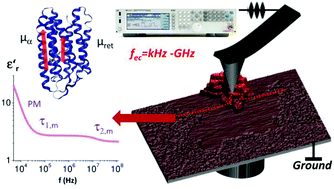Nanoscale dipole dynamics of protein membranes studied by broadband dielectric microscopy†
Abstract
We investigate the nearfield dipole mobility of protein membranes in a wide frequency range from 3 kHz to 10 GHz. The results of our nanoscale dielectric images and spectra of bacteriorhodopsin (bR) reveal Debye relaxations with time constants of τ ∼ 2 ns and τ ∼ 100 ns being characteristic of the dipole moments of the bR retinal and α-helices, respectively. However, the dipole mobility and therefore the protein biophysical function depend critically on the amount of surface water surrounding the protein, and the characteristic mobility in the secondary structure is only observed for humidity levels <30%. Our results have been achieved by adding the frequency as a second fundamental dimension to quantitative dielectric microscopy. The key elements for the success of this advanced technique are the employed heterodyne detection scheme, the broadband electrical signal source, a high frequency optimized cabling, development of calibration procedures and precise finite element modelling. Our study demonstrates the exciting possibilities of broadband dielectric microscopy for the investigation of dynamic processes in cell bioelectricity at the individual molecular level. Furthermore, the technique may shed light on local dynamic processes in related materials science applications like semiconductor research or nano-electronics.



 Please wait while we load your content...
Please wait while we load your content...